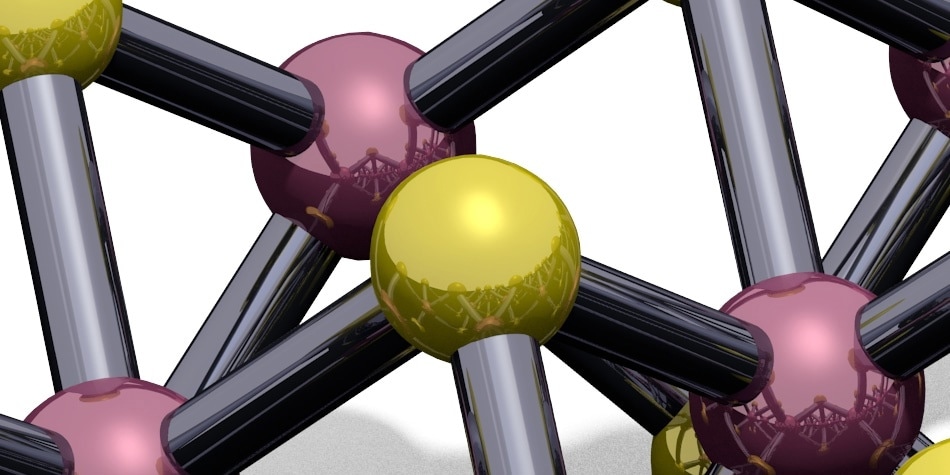
Image Credit: Shutterstock.com/ogwen
Two-dimensional (2D) materials describe a specific class of nanomaterials that are comprised of only one or two atoms thickness1. Of one of the most popular 2D materials is graphene, which is a single layer of tightly packed carbon atoms.
Aside form graphene, other popular 2D materials include semiconducting transition metal dichalogenides (TMDs), black phosphorus, silicone, and several others2. These 2D materials exhibit a number of extraordinary properties including increased strength, lightweight composition and impressive flexibility.
As a result of their excellent ability to conduct both heat and electricity, 2D materials are often incorporated into products such as imaging diagnostics, sensors and measurement devices, conductive films, batteries, fuel cells, filtration, super capacitators, and several others3.
As a newly emerging 2D material, molybdenum disulphide has found a promising place in the future of traditional microprocessor equipment. Microprocessors, or central processing units (CPU), describe the functional aspect of most modern digital circuits that are found in computers and laptops4.
While silicon is most often used as the main components in the production of such microprocessors, the approaching limited supply of this material is slowly becoming more of a reality. Molybdenum exhibits several unique properites that could be useful in the application of such devices.
Along with holding one of the highest melting temperatures as compared to all other elements, molybdenum, when added to steel and cast irons, has been found to increase the strength, toughness, weldability, hardenability and corrosion resistance of its newly formed material5.
A recent research projected conducted by a team of researchers at the Vienna University of Technology in Austria have looked at how the addition of molybdendum disulfide into a 1-bit microprocessor that has a surface area of 0.6mm2 and is composed of 115 transistors could positively affect the properties of this semiconductor.
In their device, all basic building blocks that are found in most microprocessors was kept the same, except for the use of molybdenum disulfide that acted as a carrier medium within the microprocessor. Some of the basic building blocks that are found in most microprocessors, as well as the one developed in this study, will include:
- Arithmetic Logic Unit (ALU). This unit is found at the heart of the microprocessor, and it is responsible for performing most of the basic logical and arithmetic operations within the processor.
- Accumulator (AC). This storage center is responsible for holding most of the operands that will be supplied to the ALU.
- Instruction Register (IR): This component will store the memory content of the processor that is waiting to be executed.
- Control Unit (CU). This unit will receive any instruction unit that is supplied from the IR to direct the enabling components of the microprocessor to begin operation.
- Program Counter (PC). This unit will supply the microprocessor with the s previously stored memory in order to allow for active instruction.
- Output Register (OR): This unit will allow the microprocessor to transfer the results of an acquired calculation into the output port.4
The experiment performed by this group of researchers involved the fabrication of 18 different devices, in which the molybdenum sulfide bilayer films were applied to a silicon wafer through chemical vapor deposition (CVD).
Once successfully attached, each of the previously described subunits were eventually bonded together with these newly developed wafer. While some of the 18 developed devices failed as a result of the failure of the molybdenum sulfide film to grow onto the target substrate, most of the devise exhibited a greater overall yield in the performance of their subunits6.
This group of researchers is hopeful that the future integration of 2D materials into microprocessors can be a realistic future and alternative to the traditional silicon application. Aside from possibly allowing for an increased performance rate, the addition of 2D materials, like molybdenum sulfide, could also enhance the flexibility of electronic devices, which is particularly important for products such as medical sensors and flexible display screens.
References:
- "2D Materials." Department of Materials Science and Engineering. Penn State University.
- "Graphene - What Is It?" Graphenea. Web. https://www.graphenea.com/pages/graphene#.WO780leTTww.
- "Applications." Graphene Enabled Systems Ltd. 09 June 2016.
- Stefan Wachter, Dmitry K. Polyushkin, Ole Bethge, Thomas Mueller, A microprocessor based on a two-dimensional semiconductor. Nature Communications, nature.com/articles/doi:10.1038/ncomms14948.
- Association, IMOA International Molybdenum. Molybdenum Properties. Web. http://www.imoa.info/molybdenum/molybdenum-properties.php#.
- Association, IMOA International Molybdenum. Molybdenum Properties. Web. http://www.imoa.info/molybdenum/molybdenum-properties.php#.
Disclaimer: The views expressed here are those of the author expressed in their private capacity and do not necessarily represent the views of AZoM.com Limited T/A AZoNetwork the owner and operator of this website. This disclaimer forms part of the Terms and conditions of use of this website.